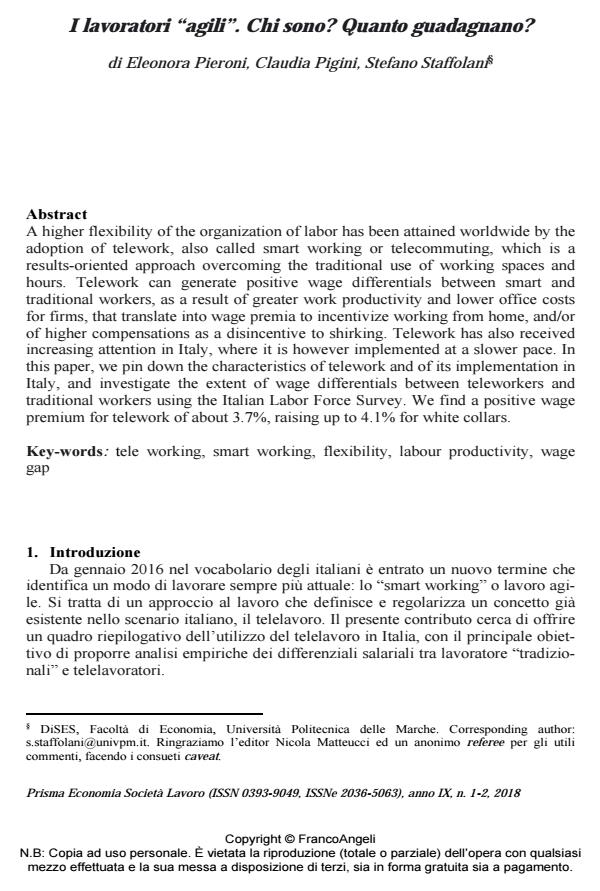I lavoratori "agili". Chi sono? Quanto guadagnano?
Titolo Rivista PRISMA Economia - Società - Lavoro
Autori/Curatori Eleonora Pieroni, Claudia Pigini, Stefano Staffolani
Anno di pubblicazione 2019 Fascicolo 2018/1-2 Lingua Italiano
Numero pagine 10 P. 67-76 Dimensione file 208 KB
DOI 10.3280/PRI2018-001005
Il DOI è il codice a barre della proprietà intellettuale: per saperne di più
clicca qui
Qui sotto puoi vedere in anteprima la prima pagina di questo articolo.
Se questo articolo ti interessa, lo puoi acquistare (e scaricare in formato pdf) seguendo le facili indicazioni per acquistare il download credit. Acquista Download Credits per scaricare questo Articolo in formato PDF

FrancoAngeli è membro della Publishers International Linking Association, Inc (PILA)associazione indipendente e non profit per facilitare (attraverso i servizi tecnologici implementati da CrossRef.org) l’accesso degli studiosi ai contenuti digitali nelle pubblicazioni professionali e scientifiche
;
Keywords:Tele working, smart working, flexibility, labour productivity, wage gap
- Baumeister R.F. and Leary M.R., (1995) “The need to belong: Desire on interpersonal attachments as a fundamental human motivation”, Psychological Bulletin, Vol. 117, No. 3, pp. 497-529
- Becker G.S., and Murphy K.M., (1992) “The division of labor, coordination costs and Knowledge”, Quarterly journal of economics, 107, pp.1137-1160
- Connelly J., (1995) “Let’s hear it for the office”, Fortune, 131, pp. 221-222
- Corso M., Gandini I. and Crespi F., (2013) “La diffusione e i benefici dello smart working in Italia”, report, Dipartimento di ingegneria gestionale, Politecnico di Milano, Milan
- Dahlstrom T.R., (2013) “Telecommuting and leadership style”, Public Personnel Management, 42, pp. 438-452
- Eurofound, (2010) “Telework in the European Union”, Eurofund Report, Loughlinstown, -- disponibile a: https://www.eurofound.europa.eu/publications/report/2010/telework-in-the-european-union
- Gajendran R.S. and Harrison D.A., (2007) “The good, the bad and the unknown about telecommuting: meta-analysis of psychological mediators and individual consequences”, Journal of applied psychology, Vol. 92, No. 6, pp. 1524-1541
- Glass J.L., and Noonan M.C., (2016) “Telecommuting and earnings trajectories among American women and men 1989-2008”, Social Forces, pp.1-34
- Golden T.D., Veiga J. and Simsek Z., (2006), “Telecommuting’s differential impact on work-family conflict: Is there no place like home?”, Journal of Applied Psychology, 91, pp. 1340-1350
- Greenhaus J. and Beutell N., (1985) “Sources and conflict between work and family roles”, Academy of Management Review, Vol. 10, pp. 76-88
- Harpaz I., (2002) “Advantages and disadvantages of telecommuting for the individual, organization and society”, Work study, Vol. 51, No. 2, pp. 74-80
- Hesse B. and Grantham C.E., (1991) “Electronically distributed work communities: implications for research on telework”, Electronic networking: Research application and policy, Vol. 1, pp. 4-17
- Igbaria M. and Guimaraes T., (1999) “Exploring differences in employee turnover intentions and its determinants among telecommuters and non-telecommuters”, Journal of management information systems”, Vol. 16, No. 1, pp. 147-1164
- Johnson N.B. and Provan K.G., (1995) “The relationship between work/family benefits and earnings: a test of competing predictions”, Journal of socio-economics, Vol. 24, No. 4, pp. 571-584
- Mason J.C., (1993) “Workplace 200: The death of 9 to 5?”, Management Review, 82, pp.14-18
- Pérez M.P., Sànchez A.M. and de Louis Carnicer M.P., (2002) “Benefits and barriers of telework: differences of human resources managers according to company’s operations strategy”, Technovation, 22, pp. 775-783
- Pigini C. and Staffolani S., (2019) “Teleworkers in Italy: who are they? Do they make more?”, International Journal of Manpower, DOI: 10.1108/IJM-07-2017-015
- Schroeder C. and Warren R.S., (2005) “The effect of home-based work on earnings”, Unpublished manuscript
- Thomas L.T. and Ganster D.C., (1995) “Impact of family-supportive work variables on work-family conflict and strain: a control perspective”, Journal of applied psychology, 80, pp. 6-15
- Winder K.L., (2009) “Flexible work arrangements and wages: do firm characteristics matter?”, Working paper, University of California-Merced
Eleonora Pieroni, Claudia Pigini, Stefano Staffolani, I lavoratori "agili". Chi sono? Quanto guadagnano? in "PRISMA Economia - Società - Lavoro" 1-2/2018, pp 67-76, DOI: 10.3280/PRI2018-001005